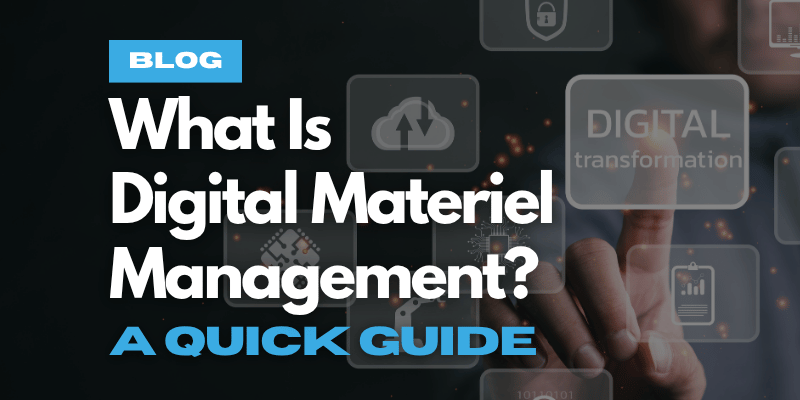Creating a Data Management Plan for Digital Engineers
A Data Management Plan (DMP) is a crucial digital engineering tool for systems and digital engineers, serving as a visual framework that organizes...
4 min read
SPEC Innovations Team
:
6/6/24 10:00 AM

The United States Air Force (USAF) has long been at the forefront of technological innovation, and its adoption of digital materiel management (DMM) is no exception. This modern approach to logistics and supply chain management is transforming how the Air Force maintains its readiness and operational efficiency. Let's explore how the Air Force is implementing and the significant impacts it is having on the USAF.
Digital Materiel Management is the use of digital tools and technologies to manage materials and supplies. This includes the integration of advanced software systems, data analytics, and automation to streamline inventory control, procurement, and distribution processes. The objective is to enhance visibility, accuracy, and speed in the supply chain, ensuring that necessary materials are available where and when they are needed.
📖 Learn More: What Is Digital Materiel Management? - A Quick Guide
The USAF's transition to DMM is part of a broader strategy to modernize its logistics operations. This involves several key initiatives:
The Air Force is using advanced inventory management systems that leverage artificial intelligence (AI) and machine learning (ML). These systems predict demand patterns and optimize stock levels, reducing the risk of overstocking or stockouts.
DMM allows for real-time tracking of materials using technologies like RFID (Radio-Frequency Identification) and IoT (Internet of Things) devices. This enhances transparency and provides up-to-the-minute data on the location and status of critical supplies.
Automated processes are being introduced to handle routine tasks such as order processing and inventory updates. This reduces human error and frees up personnel to focus on more strategic activities.
The USAF is moving towards integrated digital platforms that connect various aspects of the supply chain. These platforms offer a unified view of operations, enabling better coordination and informed decision-making.
The implementation of digital material management brings several benefits to the United States Air Force:
By optimizing inventory levels and automating processes, the Air Force can significantly reduce operational costs. Improved efficiency also means that resources can be reallocated to other critical areas.
The DoD has been looking at implementing a digital approach for the last 20 years. AFMC and Project Kessel Run highlight the successful implementation of DMM within the USAF.
The USAF's commitment to digital transformation in material management is expected to continue growing. Future developments may include more sophisticated AI applications, further integration with other military branches, and the adoption of blockchain technology to enhance security and traceability in the supply chain.
Digital Materiel Management is revolutionizing how the USAF handles logistics and supply chain operations. Through advanced technologies and innovative strategies, the Air Force is enhancing its readiness, efficiency, and sustainability, ensuring it remains prepared to meet the challenges of the future.
Effective digital materiel management starts with well-defined requirements. Innoslate provides a powerful platform for managing and tracking requirements throughout a project's lifecycle. This ensures that all material management needs are clearly defined, documented, and traceable, reducing the risk of miscommunication and errors.
Innoslate’s system modeling capabilities allow users to create detailed models of logistics and supply chain systems. These models can simulate different scenarios and assess the impact of various strategies on materiel flow and inventory levels. By using these simulations, the USAF can optimize its supply chain processes and improve decision-making.
Digital material management involves the entire lifecycle of materials, from acquisition to disposal. Innoslate supports lifecycle analysis by providing tools to track and manage materials through each phase. This ensures that materials are used efficiently and that lifecycle costs are minimized.
Innoslate’s integrated data management capabilities enable the seamless collection, storage, and analysis of data from multiple sources. This is crucial for maintaining real-time visibility into inventory levels, materiel conditions, and supply chain performance. The ability to integrate with other systems and databases ensures that all relevant information is available for decision-making.
Effective digital materiel management requires collaboration across various departments and stakeholders. Innoslate facilitates this through its collaborative platform, allowing team members to share information, provide updates, and collaborate on tasks in real time. This enhances coordination and ensures that everyone is aligned with the overall materiel management strategy.
Managing risks is a critical component of digital materiel management. Innoslate provides tools for identifying, assessing, and mitigating risks associated with materiel supply and logistics operations. This proactive approach to risk management helps prevent disruptions and ensures continuity of operations.
📖 Learn More: How to Perform Risk Management in Innoslate
Compliance with regulations and standards is essential in military logistics. Innoslate helps ensure compliance by providing a comprehensive audit trail and reporting capabilities. This makes it easier to generate reports, track compliance status, and address any issues promptly.
Innoslate’s project and program management features support the planning, execution, and monitoring of materiel management initiatives. This includes task scheduling, resource allocation, and progress tracking, ensuring that projects stay on track and meet their objectives.
Innoslate can help your organization implement a digital material management strategy to enhance logistics operations, improve efficiency, and maintain a high level of readiness. Innoslate’s comprehensive suite of tools provides the capabilities needed to manage complex material and supply chain challenges effectively.
Have questions about model-based systems engineering or requirements management? Talk to an expert and see how Innoslate can streamline your projects from start to finish.
A Data Management Plan (DMP) is a crucial digital engineering tool for systems and digital engineers, serving as a visual framework that organizes...

What is Digital Materiel Management? Digital Materiel Management (DMM) is a modern approach to managing the entire lifecycle of materiel, supplies,...
.png)
A 2 Step Approach to Digital Engineering SPEC Innovations takes a unique approach to digital engineering (DE). Step 1: We began by developing a...